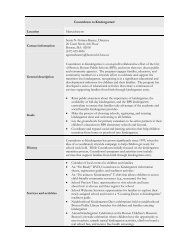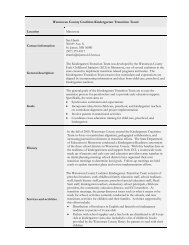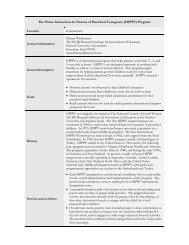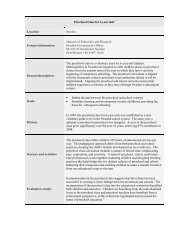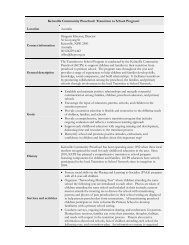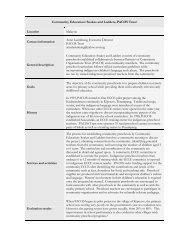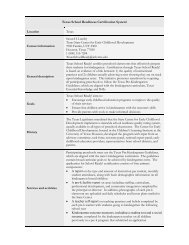Proceedings of the Fourth Annual Teachers College Educational ...
Proceedings of the Fourth Annual Teachers College Educational ...
Proceedings of the Fourth Annual Teachers College Educational ...
Create successful ePaper yourself
Turn your PDF publications into a flip-book with our unique Google optimized e-Paper software.
Youth in <strong>the</strong> Digital Age: Digital Media and Technologies for<br />
Supporting Civic Engagement<br />
Tenzin Doleck,<br />
<strong>Teachers</strong> <strong>College</strong>, Columbia University, 525 W. 120th Street, New York, NY<br />
Email: tcd2116@columbia.edu<br />
The proliferation <strong>of</strong> technology is undoubtedly having a pr<strong>of</strong>ound impact on our lives. This power <strong>of</strong> digital<br />
media, <strong>the</strong> Internet, and social networking was fully realized recently in <strong>the</strong> wake <strong>of</strong> <strong>the</strong> high-pr<strong>of</strong>ile<br />
uprisings in <strong>the</strong> Arab World as citizens used this digital space and tools as a catalyst for effecting reform.<br />
As technology permeates more aspects <strong>of</strong> our lives, <strong>the</strong> transformative consequences are being felt.<br />
There are key aspects/areas in democracy where <strong>the</strong> effects <strong>of</strong> technology are clearly visible: elections,<br />
campaigns, governance, civic participation, etc. The Internet and new digital media helps users to be<br />
informed and empowered by providing a voice for all users who normally would not take part in <strong>the</strong><br />
political process and also creates opportunities for all interests to be heard; thus, <strong>the</strong> platform and power<br />
that technology affords has <strong>the</strong> potential to serve as a catalyst and vehicle for civic engagement, a critical<br />
element <strong>of</strong> democratic process. Technology certainly has <strong>the</strong> potential, power, and affordances to<br />
ameliorate <strong>the</strong> ways and chances to participate and engage in civic activities.<br />
The vast majority <strong>of</strong> youth in America are online (Madden, 2006). The increased penetration <strong>of</strong> <strong>the</strong><br />
Internet along with <strong>the</strong> technology readiness <strong>of</strong> today’s youth has begetted increased online activities. A<br />
report published by <strong>the</strong> Kaiser Foundation highlights that <strong>the</strong> total media usage <strong>of</strong> children (8-18 year<br />
olds) has increased more than an hour in <strong>the</strong> past decade and mobile media ownership among 8-18 year<br />
olds has also gone up significantly in <strong>the</strong> past five years (Rideout, Foehr, & Roberts, 2010). Bennet<br />
(2008) acknowledges <strong>the</strong> vibrancy <strong>of</strong> youth civic engagement and <strong>the</strong> growing trend <strong>of</strong> young people<br />
employing creative uses <strong>of</strong> technology in civic issues, but points out that in cases where <strong>the</strong>y do display<br />
political involvement “it is <strong>of</strong>ten related to lifestyle concerns that seem outside <strong>the</strong> realm <strong>of</strong> government.”<br />
Attachment to <strong>the</strong> digital space has also resulted in detachment from <strong>the</strong> geographic space, “America’s<br />
youth appear to be disconnecting from public life, and doing so at a rate that is greater than for any o<strong>the</strong>r<br />
age group” (Carpini, 2000). In light <strong>of</strong> <strong>the</strong> rising trends <strong>of</strong> youth’s dissatisfaction and disenchantment with<br />
conventional politics, it becomes imperative to understand potential positive benefits <strong>of</strong> digital media and<br />
communication technologies in spurring youth civic engagement so that it can help reverse <strong>the</strong> long-term<br />
declines in civic and political participation among youth. As Greene (1985) writes, “surely it is an<br />
obligation <strong>of</strong> education in a democracy to empower <strong>the</strong> young to become members <strong>of</strong> <strong>the</strong> public, to<br />
participate, and play articulate roles in <strong>the</strong> public space."<br />
Youth are avid users <strong>of</strong> digital media and communication technologies, as such <strong>the</strong>re is a greater<br />
likelihood that <strong>the</strong>se technologies will be an important part <strong>of</strong> <strong>the</strong>ir civic lives; most real <strong>of</strong>fline activities<br />
already have or will have an online equivalent. Montgomery highlights that <strong>the</strong> “youth are in many ways<br />
<strong>the</strong> defining users <strong>of</strong> <strong>the</strong> new media”, that <strong>the</strong>re has been a rise in interest in youth’s use <strong>of</strong> digital media<br />
and how it can be used effectively in engaging youth in civic participation (Montgomery, 2008). Moreover,<br />
according to Xenos and Foot (2008) “<strong>the</strong> demand for political information on <strong>the</strong> Web among young<br />
people rivals or eclipses that <strong>of</strong> those in o<strong>the</strong>r age groups.” Youth today are using, creating, learning, and<br />
communicating in new ways. With <strong>the</strong> emergence <strong>of</strong> new technologies, youth can find meaningful ways to<br />
incorporate <strong>the</strong>se technologies into <strong>the</strong>ir civic lives. Thus, it is important to comprehend how <strong>the</strong><br />
innovative uses <strong>of</strong> technologies by <strong>the</strong> youth are expanding <strong>the</strong> boundaries <strong>of</strong> civic participation and<br />
engagement.<br />
This paper examines many <strong>of</strong> <strong>the</strong> digital media and communication technologies available, and <strong>the</strong><br />
positive affordances <strong>of</strong> and creative uses <strong>of</strong> such technologies by <strong>the</strong> youth in civic engagement. Fur<strong>the</strong>r<br />
we provide examples and examine how new technologies are being and can be used by youth for civic<br />
engagement and link <strong>the</strong>se to broader questions <strong>of</strong> youth civic engagement.<br />
14



